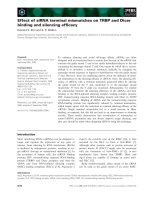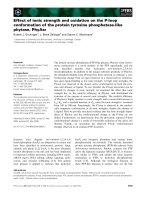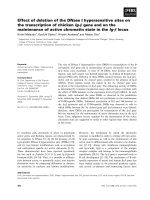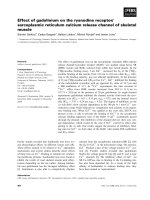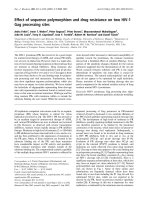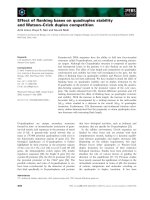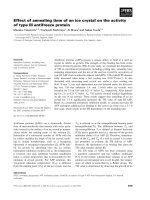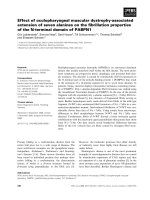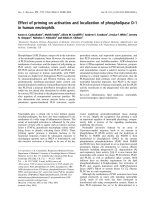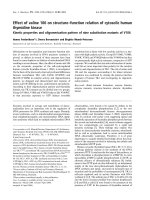Báo cáo khoa học: Effect of heliquinomycin on the activity of human minichromosome maintenance 4/6/7 helicase pdf
Bạn đang xem bản rút gọn của tài liệu. Xem và tải ngay bản đầy đủ của tài liệu tại đây (423.59 KB, 10 trang )
Effect of heliquinomycin on the activity of human
minichromosome maintenance 4/6/7 helicase
Yukio Ishimi
1,2
, Takafumi Sugiyama
1
, Ryou Nakaya
1
, Makoto Kanamori
3
, Toshiyuki Kohno
2
,
Takemi Enomoto
3
and Makoto Chino
4
1 College of Science*, Ibaraki University, Japan
2 Macromolecular Structure Research Group*, Mitsubishi Kagaku Institute of Life Sciences, Tokyo, Japan
3 Molecular Cell Biology Laboratory, Graduate School of Pharmaceutical Sciences, Tohoku University, Miyagi, Japan
4 Pharmaceuticals Group, Nippon Kayaku Co. Ltd., Tokyo, Japan
Minichromosome maintenance (MCM) proteins are
essential factors for the prevention of the loss of extra-
chromosomal DNA in Saccharomyces cerevisiae [1–3].
A heterohexameric MCM2–7 protein complex has been
identified as a component of the DNA replication
licensing system that ensures a single round of DNA
replication per cell cycle [4–7]. This complex functions
as a replicative DNA helicase that drives the unwinding
of the DNA duplex prior to semiconservative DNA
synthesis at the replication forks. This notion is sup-
ported by the following findings. First, all of the
MCM2–7 proteins possess DNA-dependent ATPase
motifs that are common features of DNA helicases [8].
Second, the MCM4/6/7 subcomplex forms the core of
the MCM2–7 hexamer and exhibits intrinsic DNA
helicase activity in vitro [9–12]. Third, in S. cerevisiae,
MCM2–7 proteins play an essential role in both the ini-
tiation and elongation of DNA replication [13], and
these proteins migrate on the genome together with the
replication forks [14,15]. One of the intricacies related
to the function of the MCM2–7 complex is that an iso-
lated MCM2–7 complex does not exhibit definite DNA
helicase activity in vitro, but the MCM4/6/7 hexamer
does. Further, the interaction between the MCM2
protein and the MCM4/6/7 hexamer, or between the
MCM3/5 proteins and the MCM4/6/7 hexamer,
Keywords
anticancer drug; DNA replication; MCM
4/6/7 helicase
Correspondence
Y. Ishimi, Ibaraki University, 2-1-1 Bunkyo,
Mito, Ibaraki 310-8512, Japan
Fax: +81 29 228 8439
Tel: +81 29 228 8439
E-mail:
(Received 9 March 2009, revised 13 April
2009, accepted 16 April 2009)
doi:10.1111/j.1742-4658.2009.07064.x
The antibiotic heliquinomycin, which inhibits cellular DNA replication at a
half-maximal inhibitory concentration (IC
50
) of 1.4–4 lm, was found to inhi-
bit the DNA helicase activity of the human minichromosome maintenance
(MCM) 4/6/7 complex at an IC
50
value of 2.4 lm. In contrast, 14 lm heliqui-
nomycin did not inhibit significantly either the DNA helicase activity of the
SV40 T antigen and Werner protein or the oligonucleotide displacement
activity of human replication protein A. At IC
50
values of 25 and 6.5 lm,
heliquinomycin inhibited the RNA priming and DNA polymerization activi-
ties, respectively, of human DNA polymerase-a/primase. Thus, of the
enzymes studied, the MCM4/6/7 complex was the most sensitive to heliqui-
nomycin; this suggests that MCM helicase is one of the main targets of
heliquinomycin in vivo. It was observed that heliquinomycin did not inhibit the
ATPase activity of the MCM4/6/7 complex to a great extent in the absence
of single-stranded DNA. In contrast, heliquinomycin at an IC
50
value of
5.2 lm inhibited the ATPase activity of the MCM4/6/7 complex in the pres-
ence of single-stranded DNA. This suggests that heliquinomycin interferes
with the interaction of the MCM4/6/7 complex with single-stranded DNA.
Abbreviations
BrdU, bromodeoxyuridine; FITC, fluorescein isothiocyanate; IC
50,
half-maximal inhibitory concentration; MCM, minichromosome
maintenance; RPA, replication protein A.
*[Corrections added on 18 May 2009 after first online publication: in affiliation 1, ‘Macromolecular Structure Research Group’ has been
replaced by ‘College of Science’, and in affiliation 2 ‘Macromolecular Structure Research Group’ has been inserted.]
3382 FEBS Journal 276 (2009) 3382–3391 ª 2009 The Authors Journal compilation ª 2009 FEBS
inhibits helicase activity [16,17]. On the basis of these
previous reports, we propose that a structural change
in the MCM2–7 complex may generate the MCM4/6/7
hexamer, which, in turn, exhibits helicase activity.
Another possibility is that the DNA helicase activity of
the MCM2–7 complex may be attributed to the inter-
action of this complex with other proteins. It has been
reported that the CMG complex, which consists of the
Cdc45 protein, MCM2–7 hexamer and the GINS com-
plex purified from Drosophila embryo extracts, exhibits
DNA helicase activity in vitro [18]. Furthermore, it has
been demonstrated recently that the MCM2–7 complex
prepared from S. cerevisiae exhibits DNA helicase
activity in the presence of potassium acetate or gluta-
mate. These results suggest that the MCM2–7 complex
functions as a replicative DNA helicase in vivo [19].
Heliquinomycin, which is an antibiotic [20,21], inhib-
its cellular DNA replication and RNA synthesis. To
elucidate its cellular targets for the inhibition of DNA
synthesis, we examined the effects of heliquinomycin
on the DNA helicase activities of the MCM4/6/7 com-
plex, SV40 T antigen and Werner protein, on the oligo-
nucleotide displacement activity of replication protein
A (RPA), and on the RNA priming and DNA poly-
merization activities of the DNA polymerase-a/primase
complex. The results indicated that, among all the
enzymes examined, the MCM4/6/7 helicase was the
most sensitive to heliquinomycin. It was observed that,
in the absence of single-stranded DNA, heliquinomycin
did not inhibit the ATPase activity of the MCM4/6/7
complex to a great extent; in contrast, in the presence
of DNA, this antibiotic inhibited the ATPase activity.
This result suggests that heliquinomycin inhibits the
helicase activity of MCM4/6/7 by interfering with the
interaction of this complex with single-stranded DNA.
Results
Sensitivity of cellular DNA replication to
heliquinomycin
Heliquinomycin with a relative molecular mass of
698 Da was isolated from Streptomyces sp. as an anti-
biotic (Fig. S1) [20]. It has been shown that heliquino-
mycin inhibits DNA replication in various transformed
cells at a half-maximal inhibitory concentration (IC
50
)
of 1.4–4 lm [21]. In these experiments, DNA synthesis
was measured by the incorporation of labelled thymi-
dine into DNA. To confirm this, human HeLa cells
were pulse labelled with bromodeoxyuridine (BrdU) in
the presence of increasing concentrations of heliquino-
mycin (Fig. 1A). BrdU incorporated into DNA was
detected by staining the cells with anti-BrdU Ig and
A
B
Fig. 1. Effect of heliquinomycin (HQ) on the incorporation of BrdU
into DNA in HeLa cells. (A) Logarithmically growing HeLa cells were
incubated with the indicated concentrations of heliquinomycin for
1 h and then pulse labelled with BrdU for 20 min. The incorporated
BrdU in the cells was detected by incubation of the cells with anti-
BrdU Ig, followed by FITC-labelled anti-rat Ig. MCM7 was detected
by incubation of the cells with anti-MCM7 Ig, followed by Cy3-
labelled anti-mouse Ig. (B) One hundred Cy3-stained cells were
selected, and the fluorescence intensity of FITC in the cells was
quantified. The average level of intensity in the cells cultured in the
presence of heliquinomycin was expressed in comparison with that
in the cells cultured in the absence of heliquinomycin.
Y. Ishimi et al. Inhibition of MCM4/6/7 helicase with heliquinomycin
FEBS Journal 276 (2009) 3382–3391 ª 2009 The Authors Journal compilation ª 2009 FEBS 3383
then with fluorescein isothiocyanate (FITC)-labelled
second Ig. The cells were also stained with specific Ig
to detect MCM7 protein in the nucleus. In the absence
of heliquinomycin, approximately 27% of the cells
were stained with anti-BrdU Ig. As the concentration
of heliquinomycin was increased, the proportion of
BrdU-positive cells and the intensity of the signal grad-
ually decreased. Almost no BrdU-positive cells were
detected in the presence of 14 lm heliquinomycin. In
contrast, staining with anti-MCM7 Ig was not changed
by the presence of heliquinomycin. The fluorescence
derived from the incorporated BrdU was quantified in
these experiments, and the IC
50
value was determined
to be 2.3 lm (Fig. 1B), which is similar to the value
reported previously [21].
Sensitivity of MCM4/6/7 helicase to
heliquinomycin
Heliquinomycin at an IC
50
value of 7–14 lm inhibits
the activity of the cellular DNA helicase called DNA
helicase I [22], but scarcely affects the activities of
topoisomerases and the replication of the SV40
chromosome in vitro [21]. To understand the cellular
targets of this antibiotic during DNA replication, the
effects of this antibiotic on the helicase activities of the
human MCM4/6/7 complex, SV40 T antigen and
Werner protein were examined. In addition to these
three proteins, the human DNA polymerase-a/primase
complex and the human RPA complex were purified
to near homogeneity (Fig. S2). Some unidentified pro-
teins were found in the purified DNA polymerase-a/
primase complex and the human RPA complex. It has
been reported that MCM3 interacts with DNA
polymerase-a/primase [23]. We examined the presence
of MCM4, 5 and 6 proteins in the purified DNA
+ MCM4/6/7
A
B
+ Tag
0
(μ
M)
0.43
1.4
4.3
14
43
HQ
0
0.43
1.4
4.3
14
43
%
17-mer
17-mer/M13
0
(μ
M) HQ
0.43 1.4 4.3
14
43
Tag
MCM
0
(μ
M) HQ
0.43
120
100
80
60
40
20
0
1.4
4.3
14
43
%
+ Werner
0 0.43
1.4
4.3 14 43
(μM)
HQ
17-mer
17-mer/M13
Fig. 2. Effect of heliquinomycin on DNA helicase activity. (A) Top:
effects of increasing concentrations of heliquinomycin (HQ) on the
DNA helicase activities of the MCM4/6/7 complex and the SV40 T
antigen. Dimethyl sulfoxide solution (0.4 lL) containing or lacking
heliquinomycin was added to the reaction mixture. The final con-
centrations of heliquinomycin added to the reaction mixture are
indicated at the top. The DNA helicase activity was measured as
the activity that displaces 17-mer oligonucleotides annealed to
M13mp18 single-stranded DNA. Bottom: the proportion of dis-
placed 17-mer oligonucleotides in total DNA was considered to be
100% in the control reaction mixture lacking heliquinomycin, and
the proportions in the mixtures containing heliquinomycin were cal-
culated in relation to the control value. The horizontal line is dis-
played on a logarithmic scale. Four independent experiments were
performed for the MCM4/6/7 complex, and an average of the val-
ues was plotted together with the standard deviations. Two inde-
pendent experiments were performed for the T antigen and an
average of the values was plotted. (B) Top: effects of increasing
concentrations of heliquinomycin on the DNA helicase activity of
the Werner protein. Bottom: proportion of displaced 17-mer oligo-
nucleotides. Two independent experiments were performed, and
an average of the values was plotted together with the error bars.
Inhibition of MCM4/6/7 helicase with heliquinomycin Y. Ishimi et al.
3384 FEBS Journal 276 (2009) 3382–3391 ª 2009 The Authors Journal compilation ª 2009 FEBS
polymerase-a/primase complex (Fig. S3). Only small
amounts of MCM4 (0.1% of total protein) and
MCM5 (0.9%) proteins were detected, and MCM6
was not found.
DNA helicases were added to the DNA helicase
reaction mixtures at the minimum amounts required to
displace almost all of the 17-mer oligonucleotides.
Heliquinomycin at a concentration of 14 lm did not
inhibit the helicase activity of the SV40 T antigen to a
great extent, but inhibited that of the MCM4/6/7 com-
plex at an IC
50
value of 2.4 lm (Fig. 2A). Heliquino-
mycin (14 lm) did not inhibit the helicase activity of
the Werner protein to a great extent (Fig. 2B). It
should be noted that the mobility of displaced frag-
ments in the absence or presence of heliquinomycin
was different. The RPA complex displaces oligonucleo-
tides annealed to M13 single-stranded DNA without
triggering ATP hydrolysis [24]. We found that heliqui-
nomycin scarcely affected the oligonucleotide displace-
ment activity of RPA (Fig. S4). We also examined the
effect of heliquinomycin on the reactions of RNA
priming (Fig. 3A) and DNA polymerization activity
(Fig. 3B) of the DNA polymerase-a/primase complex.
When dT
50
was used as a template, an RNA primer of
approximately 10 nucleotides was synthesized only in
the presence of the above complex. The synthesis
of the RNA primer was inhibited in the presence of
heliquinomycin at an IC
50
value of 25 lm. The DNA
polymerization activity of the DNA polymerase-a/
primase complex was measured using activated DNA
as a template and a primer. The observed reduction in
the level of the incorporated nucleotides indicates that
heliquinomycin at an IC
50
value of 6.5 lm inhibits the
DNA polymerization activity of the complex. These
results indicate that, among the enzymes studied,
MCM4/6/7 is the most sensitive to heliquinomycin and
the DNA polymerase-a/primase complex is also rela-
tively sensitive to this antibiotic (Table 1).
Sensitivity of MCM4/6/7 helicase to
heliquinomycin
To understand the mechanism by which heliquino-
mycin inhibits the activity of MCM4/6/7 helicase, we
0 0.43 1.4 4.3 14 43
HQ (μ
M)
%
0
(μ
M)
0.43
1.4
4.3
14
43
HQ
17
10
50
nt
+ Polα-primase
A
B
0
(μ
M) HQ
0.43 1.4 4.3 14 43
%
120
100
80
60
40
20
0
100
80
60
40
20
0
Fig. 3. Effect of heliquinomycin on the RNA priming activity of the
DNA polymerase-a/primase complex. (A) Top: effect of increasing
concentrations of heliquinomycin (HQ) on the RNA priming action
of the DNA polymerase-a/primase. RNA priming activity was mea-
sured by the analysis of oligoA synthesis when dT
50
was used as
the template. The products were electrophoresed under denaturing
conditions. The three oligonucleotides of A
10
, 17-mer and dT
50
were labelled at their 5¢ ends and electrophoresed to determine the
size of the synthesized oligoA fragment. The arrow indicates the
position of the RNA primer synthesized by DNA polymerase-a/prim-
ase. Bottom: radioactivity of the synthesized RNA primer. The
radioactivity recorded for RNA in the control reaction mixture lack-
ing heliquinomycin was considered to be 100%, and that recorded
for the reaction mixtures containing heliquinomycin was presented
in relation to this control value. Two independent experiments were
performed, and an average of the values was plotted together with
error bars. (B) Effect of increasing concentrations of heliquinomycin
on the DNA polymerization activity of the DNA polymerase-a/prim-
ase. The reaction was performed using activated DNA as a primer
and template. The acid-insoluble radioactive material trapped on the
glass fibre filter was measured. The radioactivity recorded in the
case of the control reaction mixture lacking heliquinomycin was
considered to be 100%, and that recorded for the reaction mixture
containing heliquinomycin was presented in relation to this control
value. Two independent experiments were performed, and an aver-
age of the data was plotted together with the error bars.
Y. Ishimi et al. Inhibition of MCM4/6/7 helicase with heliquinomycin
FEBS Journal 276 (2009) 3382–3391 ª 2009 The Authors Journal compilation ª 2009 FEBS 3385
examined the effect of heliquinomycin on the formation
of the MCM4/6/7 complex (Fig. 4). In the absence of
heliquinomycin, the MCM4/6/7 complex, as detected
using anti-MCM4 IgG, exhibits a trimeric or hexameric
structure, depending on its mobility in the gel. We
observed that the hexamer–trimer proportion increased
slightly with an increase in the heliquinomycin concen-
tration. The hexameric form of the MCM4/6/7 complex
was dominant in the presence of 14 lm of heliquino-
mycin, and larger complexes were detected in the pres-
ence of 43 lm of heliquinomycin. Thus, it appears that
higher concentrations of heliquinomycin affect signifi-
cantly the formation of the MCM4/6/7 complex. We
also examined the sensitivity of the ATPase activities
of the MCM4/6/7 complex and the SV40 T antigen
to heliquinomycin in the absence of single-stranded
DNA (Fig. 5). Heliquinomycin inhibited the ATPase
0
(μ
M) HQ
0.43
1.4
4.3
14
43
669
440
kDa
(4/6/7)
2
(4/6/7)
Fig. 4. Effect of increasing concentrations of heliquinomycin (HQ)
on the formation of the MCM4/6/7 complex. The MCM4/6/7 com-
plex was incubated in the presence or absence of heliquinomycin
and subsequently electrophoresed on a native polyacrylamide gel.
The proteins in the gel were transferred onto a filter and the
MCM4 protein was detected by incubating the filter with rabbit
anti-MCM4 IgG, followed by horseradish peroxidase-conjugated
anti-rabbit IgG. Finally, the bound antibodies were examined for
chemiluminescence using West Pico chemiluminescent substrate
(Thermo Scientific, Rockford, IL, USA). The positions to which
thyroglobulin (669 kDa) and ferritin (440 kDa) migrated in the gel
are indicated.
Tag
MCM
0
(μ
M) HQ
0.43 1.4 4.3 14 43
0
(μ
M)
0.43
1.4
4.3
14
43
HQ
0
0.43
1.4
4.3
14
43
+ MCM4/6/7
+ Tag
P
i
ATP
120
100
80
60
%
40
20
0
Fig. 5. Top: effect of increasing concentrations of heliquinomycin
(HQ) on the ATPase activities of the MCM4/6/7 complex (340 ng)
and the SV40 T antigen (200 ng) in the absence of single-stranded
DNA. After incubation under these conditions, an aliquot of the mix-
ture was subjected to thin layer chromatography. The radioactivity at
the sites to which P
i
and ATP migrated was measured, and the ratio
of the released P
i
to ATP was calculated. The ratio obtained in the
case of the reaction performed without the enzymes was subtracted
from that obtained in the reactions performed with the enzymes.
Bottom: the ratio obtained in the case of the control reaction mixture
which lacked heliquinomycin was considered to be 100%, and that
recorded for the reaction mixture that contained heliquinomycin was
presented in relation to this control value. Two independent experi-
ments were performed for the MCM4/6/7 complex, and an average
of the values was plotted together with error bars.
Table 1. Sensitivity of the enzymes to heliquinomycin. The IC50
values indicated are those calculated in the present study as well
as in a previous investigation [21]. Those determined in the pre-
vious investigation are marked by an asterisk.
IC
50
(lM)
Human cellular DNA synthesis* 1.4–4
HeLa DNA synthesis 2.5
SV40 chromosome replication in vitro*>72
T antigen helicase 43
HeLa helicase I* 7–14
hMCM4/6/7 helicase 2.4
Werner helicase > 43
Human RPA > 43
DNA polymerase a 6.5
DNA primase 25
Topoisomerase I* 145
Topoisomerase II* 43
Inhibition of MCM4/6/7 helicase with heliquinomycin Y. Ishimi et al.
3386 FEBS Journal 276 (2009) 3382–3391 ª 2009 The Authors Journal compilation ª 2009 FEBS
activities of these two helicases only slightly. We also
examined its effect on these activities in the presence of
heat-denatured, single-stranded DNA (Fig. 6); under
these conditions, the ATPase activity of the MCM4/6/7
complex increased manifold [9]. Heliquinomycin scar-
cely inhibited the ATPase activity of the T antigen, but
inhibited that of the MCM4/6/7 helicase at an IC
50
value of 5.2 lm. The ATPase activity of MCM4/6/7
was also stimulated in the presence of M13mp18 single-
stranded DNA in place of heat-denatured DNA, and
the stimulated activity was also inhibited in the pres-
ence of heliquinomycin (Fig. S5). These results suggest
that heliquinomycin interferes with the interaction of
the MCM4/6/7 complex with single-stranded DNA,
which is required to increase the ATPase activity of this
complex.
Discussion
Heliquinomycin was first characterized as a compound
that inhibits bacterial cell growth, and was found to
inhibit DNA synthesis in several cancer cells at an
IC
50
value of 1.4–4 lm [21]. In the present study, we
found that heliquinomycin inhibits BrdU incorporation
into DNA at an IC
50
value of 2.3 lm; this result is
consistent with the previous findings. The reported
study also indicated that the cell cycle progression of
HeLa cells was retarded during the S phase and the
cells were arrested in the G2 phase in the presence of
heliquinomycin [21]. Heliquinomycin inhibits the
cellular DNA helicase, helicase I, at an IC
50
value of
7–14 lm, but does not inhibit the activity of topoi-
somerases. Our study indicates that heliquinomycin
inhibits the activity of human MCM4/6/7 helicase at
an IC
50
value of 2.4 lm, but scarcely inhibits the DNA
helicase activity of the SV40 T antigen and the Werner
protein, or the oligonucleotide displacement activity of
human RPA. Further, it inhibits the RNA priming
and DNA polymerization activities of the human DNA
polymerase-a/primase at IC
50
values of 25 and 6.5 lm,
respectively. We also examined the effect of heliquino-
mycin on the DNA helicase activity of human REC-
QL4 protein. Heliquinomycin inhibited this activity at
an IC
50
value of 14 lm (data not presented). Thus,
among the enzymes studied, MCM4/6/7 helicase was
found to be the most sensitive to heliquinomycin.
These results suggest that MCM helicase and DNA
polymerases may be the critical targets of heliquinomy-
cin during cellular DNA replication. Further, we
observed that the checkpoint system that is induced by
the inhibition of DNA polymerases during DNA repli-
cation is not induced in HeLa cells treated with 4.3 lm
heliquinomycin (data not presented). This suggests that
the MCM helicase, rather than the DNA polymerases,
is the main target of heliquinomycin in vivo.
Heliquinomycin not only inhibited the helicase activ-
ity of the MCM4/6/7 complex, but also inhibited the
single-stranded DNA-dependent ATPase activity of
the complex. Heliquinomycin suppressed the ATPase
activity of the complex in the absence of single-
stranded DNA, but the enzymatic activity was
significantly less sensitive to heliquinomycin. Thus,
heliquinomycin may inhibit the ATPase activity and
DNA helicase activity of the MCM4/6/7 complex by
affecting the ability of this complex to interact with
single-stranded DNA. The finding that the activities
0
(μ
M)0.43
1.4
4.3
14
43
HQ
0
0.43
1.4
4.3
14
43
+ MCM4/6/7
A
B
+ Tag
P
i
ATP
Tag
MCM
0
(μ
M) HQ
0.43 1.4 4.3 14 43
120
100
80
60
%
40
20
0
Fig. 6. (A) Effect of increasing concentrations of heliquinomycin
(HQ) on the ATPase activities of the MCM4/6/7 complex (120 ng)
and SV40 T antigen (200 ng) in the presence of single-stranded
DNA. The radioactivity at the sites to which P
i
and ATP migrated
was measured, and the ratio of the released P
i
to ATP was calcu-
lated. The ratio in the case of the reaction performed without the
enzyme was subtracted from that in the case of the reactions per-
formed with these enzymes. (B) The ratio obtained in the case of
the control reaction mixture which lacked heliquinomycin was con-
sidered to be 100%, and that recorded for the reaction mixture that
contained heliquinomycin was presented in relation to this control
value. Two independent experiments were performed for the
MCM4/6/7 complex, and an average of the values was plotted
together with error bars.
Y. Ishimi et al. Inhibition of MCM4/6/7 helicase with heliquinomycin
FEBS Journal 276 (2009) 3382–3391 ª 2009 The Authors Journal compilation ª 2009 FEBS 3387
of DNA polymerase-a/primase are also inhibited at
higher concentrations of heliquinomycin may suggest
that heliquinomycin interacts with single-stranded
DNA to interfere with the activities. However, there is
no evidence for the interaction of heliquinomycin with
single-stranded DNA. In contrast, the formation of the
MCM4/6/7 complex was inhibited by heliquinomycin
at higher concentrations. Although these concentra-
tions are higher than those that inhibit MCM4/6/7
helicase activity, it is possible that heliquinomycin
interacts directly with the MCM4/6/7 complex to inhi-
bit the interaction of this complex with single-stranded
DNA, even at low concentrations.
MCM proteins are considered to be one of the
most sensitive diagnostic markers for the detection
of cancer cells in human tissues [25]. The expression
of MCM proteins appears to be critical for the
development of cancer cells, as this expression shows
a strong correlation with the malignant transforma-
tion of cells. The finding that MCM2–7 proteins are
overexpressed in transformed cancer cells [26]
suggests that the upregulation of MCM protein
expression may play a role in the development of
cancer cells. Consistent with this notion, it has
recently been reported that deregulated expression of
the MCM7 protein accelerates the transformation of
cells [27]. Thus, MCM proteins are among the most
critical targets for achieving the inhibition of cancer
cell growth. Furthermore, heliquinomycin may
have useful applications in the development of
MCM-specific anticancer drugs.
Materials and methods
BrdU labelling of HeLa cells
HeLa cells were cultured in Dulbecco’s modified Eagle’s
medium supplemented with 7% fetal calf serum. Cells cul-
tured on coverslips were incubated with dimethyl sulfoxide
or increasing concentrations of heliquinomycin for 1 h and
then pulse labelled with 20 lm BrdU for 20 min. After being
washed with NaCl/P
i
, the cells were fixed by incubation with
4% paraformaldehyde in NaCl/P
i
for 5 min at room tem-
perature. The cells were washed with NaCl/P
i
, and then
permeabilized and blocked by incubation with 0.1% Triton
X-100, 0.02% SDS and 2% nonfat dried milk in NaCl/P
i
for 1 h at 37 °C. The cells were incubated overnight with
anti-MCM7 mouse Ig (sc-9966; Santa Cruz Biotechnology,
Santa Cruz, CA, USA) at 4 °C in the above-mentioned
blocking solution. The cells were washed with the same
solution and then incubated with cyanine-3 (Cy3)-conju-
gated anti-rabbit IgG (Jackson ImmunoResearch, West
Grove, PA, USA) for 1.5 h at 37 °C in the blocking solu-
tion. They were then re-fixed, treated with 4 m HCl for
30 min at room temperature and incubated with rat anti-
BrdU Ig (clone BU1/75; Harlan Sera Laboratory, Belton,
Leicestershire, UK), followed by incubation with FITC-
conjugated anti-rat IgG (Cappel, Organon Teknika Corpo-
ration, Durham, NC, USA). Positive immunoreactivities
were detected with fluorescence microscopy (BX-9000;
KEYENCE, Osaka, Japan).
DNA helicase and ATPase activities of the DNA
helicases
A human MCM4/6/7 complex was prepared, and its DNA
helicase activity was measured, as reported previously,
except for some minor modifications [9]. The standard reac-
tion mixture (20 lL) contained 50 mm Tris/HCl (pH 7.9),
20 mm 2-mercaptoethanol, 10 mm ATP, 10 mm magnesium
acetate, 0.5 mgÆmL
)1
bovine serum albumin, 1–2.5 fmol of
a 17-mer oligonucleotide annealed to M13mp18 DNA and
an approximately100 ng sample of human MCM4/6/7 com-
plex, a 25 ng sample of SV40 T antigen or a 1.25 ng sample
of Werner protein, in the presence or absence of heliquino-
mycin at the indicated concentrations. This mixture was
incubated at 37 °C for 40 min, and the products were anal-
ysed using 12% PAGE. The ATPase activity was measured
by incubating either the MCM proteins (120–340 ng) or the
SV40 T antigen (200 ng) at 37 °C for 30 min in the pres-
ence of 74 kBq [c-
32
P]ATP in a solution containing 50 mm
Tris/HCl (pH 7.9), 20 mm 2-mercaptoethanol, 0.5 mgÆmL
)1
bovine serum albumin, 10 mm magnesium acetate, 10 mm
ATP and heliquinomycin at the indicated concentrations in
the presence or absence of 5 lg of single-stranded DNA
(heat-denatured). Further, 0.5 lL of the reaction mixture
was spotted onto a poly (ethyleneimine)-cellulose thin layer
chromatography plate (Cellulose F; Merck, Darmstadt,
Germany). Chromatography was performed at 4 °C for a
period of 2 h using a solution of 0.8 m acetic acid and
0.8 m LiCl. The radioactivity on the plate was detected
using a Bio-Image Analyser (FLA3000; Fuji, Tokyo,
Japan).
Formation of the MCM4/6/7 complex
The reaction mixture (10 lL) containing 50 mm Tris/HCl
(pH 7.5), 20 mm 2-mercaptoethanol, 5 mm MgCl
2
,5mm
ATP, 100 lgÆmL
)1
bovine serum albumin and the MCM4/6/
7 complex (170 ng) was incubated at 37 °C for 30 min in the
presence or absence of heliquinomycin. The resulting solu-
tion was analysed on a 5% acrylamide gel in 50 mm Tris/
HCl (pH 8.0) and 50 mm glycine. Subsequently, the gel was
immersed in a solution containing 49 mm Tris, 38 mm gly-
cine and 0.25% SDS, and was incubated at 80 °C for 1 h in
order to achieve protein denaturation. The proteins in the gel
were then transferred onto a membrane filter (Immobilon;
Inhibition of MCM4/6/7 helicase with heliquinomycin Y. Ishimi et al.
3388 FEBS Journal 276 (2009) 3382–3391 ª 2009 The Authors Journal compilation ª 2009 FEBS
Millipore, Billerica, MA, USA) and anti-MCM4 IgG were
used to detect MCM4 on the filter [9].
RNA priming and DNA synthesis with DNA
polymerase-a/primase
The DNA polymerase-a/primase complex was purified from
HeLa cells by immunoadsorption, followed by elution from
a column coated with a monoclonal antibody (SJK237), as
reported previously [28]. DNA polymerase activity was
measured using a reaction mixture (20 lL) containing
20 mm Tris/HCl (pH 7.9), 3.3 mm 2-mercaptoethanol,
0.2 mgÆmL
)1
bovine serum albumin, 5 mm MgCl
2
,
0.25 mgÆmL
)1
activated DNA, 100 lm each of dATP,
dGTP and dTTP, 50 lm of dCTP, 111 kBq [a-
32
P]dCTP
and 85 ng DNA polymerase-a/primase complex in the pres-
ence of heliquinomycin at the indicated concentrations. The
reaction was terminated by the addition of 30 lL of sodium
pyrophosphate (0.17 m) and 50 lL of sperm DNA
(1 mgÆmL
)1
). Further, 1 mL of 5% trichloroacetic acid was
added, and the acid-insoluble radioactive material trapped
on a glass fibre filter was measured in a liquid scintillation
cocktail. The reaction mixture (10 lL) used for the mea-
surement of the RNA priming activity contained 40 mm
Tris/HCl (pH 7.5), 10 mm magnesium acetate, 1 mm dithio-
threitol, 100 lgÆ mL
)1
bovine serum albumin, 0.1 mm ATP,
185 kBq [a-
32
P]ATP and 10 lm (dT)
50
in the presence of
heliquinomycin at the indicated concentrations. This mix-
ture was incubated at 37 °C for 40 min and then heated at
95 °C for 5 min. Thereafter, bacterial alkaline phosphatase
(0.6 units) was added, and the mixture was further incu-
bated at 65 °C for 30 min. The mixture was heated at
98 °C for 5 min in the presence of 3 lL of loading buffer
(0.1% bromophenol blue, 0.1% xylene cyanol, 10 mm
EDTA and 98% formamide), and the products were analy-
sed on a 25% polyacrylamide gel containing 7 m urea. The
oligonucleotides, A
10
, 17-mer and oligo-dT
50
, were labelled
at their 5¢ ends and used as markers. The gel was dried and
the radioactivity was detected using a Bio-Image Analyser.
Preparation of the RPA complex
cDNAs for human RPA1, RPA2 and RPA3 were synthe-
sized from mRNA extracted from HeLa cells by the reverse
transcription-polymerase chain reaction (RT-PCR) method
(Invitrogen, Carlsbad, CA, USA), and were cloned into the
baculovirus vectors pVL1393, pAcUW31 and pVL1393,
respectively. RPA1 was cloned to be expressed as a (His)
6
-
RPA1 fusion protein, and RPA2 as a flag-RPA2 fusion
protein. High-5 cells were co-infected with the three viruses
expressing the RPA1, RPA2 and RPA3 proteins for 2 days.
The recombinant RPA proteins in the lysates of the
infected cells were purified by performing nickel-nitrilotri-
acetic acid (Qiagen, Hilden, Germany) affinity column
chromatography as follows. The purification involved the
suspension of the infected cells in lysis buffer consisting
of 10 mm Tris/HCl (pH 7.5), 130 mm NaCl, 1% Triton
X-100, 10 mm NaF, 10 mm sodium phosphate buffer,
10 mm Na
4
P
2
O
7
and protease inhibitors (Pharmingen BD,
San Jose, CA, USA). The mixture was incubated for
40 min on ice, and insoluble components were separated by
centrifugation at 137 000 g (TLS55; Beckman, Fullerton,
CA, USA) for 40 min at 4 °C. To 1 vol of the clarified
lysate, 1/10 vol of nickel-nitrilotriacetic acid-agarose was
added, and the mixture was incubated for 1 h at 4 °Cona
rocking platform. Agarose beads were then collected by
centrifugation and thoroughly washed with buffer A
[50 mm sodium phosphate buffer (pH 6.0), 300 mm NaCl
and 10% glycerol] containing 20 mm imidazole. Next, the
beads were washed once with buffer B [50 mm sodium
phosphate buffer (pH 8.0), 300 mm NaCl and 10% glyc-
erol] containing 20 mm imidazole, and the proteins bound
to the beads were eluted by adding buffer B containing
300 mm imidazole at a volume equivalent to 1 bed. This
was followed by incubation for 5 min at 4 °C on a rocking
platform and separation of the beads by centrifugation.
The proteins were eluted twice more. The eluates were
pooled and diluted to decrease the NaCl concentration to
50 mm, and the solution thus obtained was concentrated
using Centricon 30 (Millipore). The concentrated proteins
were loaded onto a MonoQ column (GE Healthcare, Pis-
cataway, NJ, USA), and the bound proteins were eluted
using a linear NaCl gradient (0.1–0.6 m). The RPA1
(70 kDa), RPA2 (34 kDa) and RPA3 (14 kDa) proteins
were co-eluted with approximately 0.3 m NaCl, and were
concentrated using Microcon 30 after the salt concentration
had decreased to 0.1 m. The oligonucleotide displacement
activity of RPA was measured using the same reaction mix-
ture as that employed to assess the DNA helicase activity,
except that the reaction mixture contained 200 ng of RPA
complex.
Purification of Werner helicase
High-5 cells infected with recombinant virus encoding
(His)
6
-WRN were cultured for 3 days and then collected by
centrifugation. The cells were lysed with 0.5% Nonidet P-
40 in buffer C [50 mm Tris/HCl (pH 7.9), 150 mm NaCl,
10% glycerol, 1 mm phenylmethylsulfonyl fluoride and
20 lgÆmL
)1
leupeptin) for 10 min on ice, and NaCl was
added to the lysate at a final concentration of 0.5 m. After
incubation for 30 min on ice, the cell lysate was centrifuged
at 265 070 g (TLA 100.3; Beckman) for 30 min at 4 °C.
The supernatant was passed through a DE52 (Whatman,
Maidstone, Kent, UK) column equilibrated with 0.5 m
NaCl in buffer C to remove nucleic acids. Flow-through
fractions were loaded on to a nickel-nitrilotriacetic acid
affinity column equilibrated with buffer D [20 mm KP
i
(pH 7.5), 1 mm phenylmethylsulfonyl fluoride and
20 lgÆmL
)1
leupeptin] containing 0.5 m NaCl. After loading
Y. Ishimi et al. Inhibition of MCM4/6/7 helicase with heliquinomycin
FEBS Journal 276 (2009) 3382–3391 ª 2009 The Authors Journal compilation ª 2009 FEBS 3389
onto the nickel-nitrilotriacetic acid column, the column was
washed with buffer D containing 0.2 m NaCl and 25 mm
imidazole, and eluted with buffer D containing 0.2 m NaCl
and 200 mm imidazole. The fractions containing Werner
protein were determined by performing SDS–PAGE.
Pooled fractions were loaded onto a MonoS column (GE
Healthcare). After the column had been washed with buffer
H [25 mm Hepes/NaOH (pH 7.8), 1 mm EDTA, 10% glyc-
erol, 0.01% Nonidet P-40, 1 mm phenylmethylsulfonyl fluo-
ride and 20 lgÆmL
)1
leupeptin] containing 0.2 m NaCl, the
bound proteins were eluted with buffer H containing 0.5 m
NaCl. Fractions around the main peak were pooled,
concentrated using Vivaspin 20 (Sartorius, Hanover,
Germany) and then fractionated on Superdex 200 HR in
buffer H containing 0.1 m NaCl. The purified protein was
concentrated with Vivaspin and dialysed against buffer H
containing 0.1 m NaCl.
Other materials
The SV40 T antigen was prepared as reported previously
[28]. Heliquinomycin was purified from Streptomyces sp.
MJ929-SF2, as reported previously [29], and 1 mg of the
purified heliquinomycin was dissolved in 0.1 mL of
dimethyl sulfoxide to prepare a 10 mgÆmL
)1
stock solution.
To prepare activated DNA, calf thymus DNA (30 mg) was
digested for 30 min at 37 °C with DNase I (1 lg) in a mix-
ture (10 mL) containing 50 mm Tris/HCl (pH 7.5), 5 mm
MgCl
2
and 0.5 mgÆmL
)1
bovine serum albumin. The mix-
ture was heated for 5 min at 77 °C to stop the reaction and
then dialysed against 50 mm Tris/HCl (pH 8.1) and 5 mm
MgCl
2
.
Acknowledgements
This study was supported in part by a Grant-in-Aid
for Scientific Research from the Ministry of Education,
Science, Sports and Culture of Japan.
References
1 Tye BK (1999) MCM proteins in DNA replication.
Annu Rev Biochem 68, 649–686.
2 Bell SP & Dutta A (2002) DNA replication in eukary-
otic cells. Annu Rev Biochem 71, 333–374.
3 Forsburg SL (2004) Eukaryotic MCM proteins: beyond
replication initiation. Microbiol Mol Biol Rev 68, 109–
131.
4 Kubota Y, Mimura S, Nishimoto S, Takisawa H. &
Nojima H (1995) Identification of the yeast
MCM3-related protein as a component of Xenopus
DNA replication licensing factor. Cell 81, 601–609.
5 Chong JPJ, Mahbubani HM, Khoo C-Y & Blow JJ
(1995) Purification of an MCM-containing complex as a
component of the DNA replication licensing system.
Nature 375, 418–421.
6 Madine MA, Khoo C-Y, Mills AD & Laskey RA
(1995) MCM3 complex required for cell cycle regulation
of DNA replication in vertebrate cells. Nature 375,
421–424.
7 Prokhorova TA & Blow JJ (2000) Sequential MCM/P1
subcomplex assembly is required to form a heterohex-
amer with replication licensing activity. J Biol Chem
275, 2491–2498.
8 Koonin EV (1993) A common set of conserved motifs
in a vast variety of putative nucleic acid-dependent
ATPases including MCM proteins involved in the initia-
tion of eukaryotic DNA replication. Nucleic Acids Res
21, 2541–2547.
9 Ishimi Y (1997) A DNA helicase activity is associated
with an MCM4, -6, and -7 protein complex. J Biol
Chem 272, 24508–24513.
10 Lee J-K & Hurwitz J (2000) Isolation and characteriza-
tion of various complexes of the minichromosome
maintenance protein of Schizosaccharomyces pombe.
J Biol Chem 275, 18871–18878.
11 Kaplan DL, Davey MJ & O’Donnell M (2003)
Mcm4,6,7 uses a ‘pump in ring’ mechanism to unwind
DNA by steric exclusion and actively translocate along
a duplex. J Biol Chem 278, 49171–49182.
12 Bochman M & Schwacha A (2007) Differences in the
single-stranded DNA binding activities of MCM2-7 and
MCM467: MCM2 and 5 define a slow ATP-dependent
step. J Biol Chem 282, 33759–33804.
13 Labib K, Tercero JA & Diffley JF (2000) Uninterrupted
MCM2–7 function required for DNA replication fork
progression. Science 288, 1643–1647.
14 Aparicio OM, Weinstein DM & Bell SP (1997) Compo-
nents and dynamics of DNA replication complexes in
S. cerevisiae: redistribution of MCM proteins and
Cdc45p during S phase. Cell 91, 59–69.
15 Katou Y, Kanoh Y, Bando M, Noguchi H, Tanaka H,
Ashikari T, Sugimoto K & Shirahige K (2003) S-phase
checkpoint proteins Tof1 and Mrc1 form a
stable replication-pausing complex. Nature 424,
1078–1083.
16 Ishimi Y, Komamura Y, You Z & Kimura H (1998)
Biochemical function of mouse minichromosome main-
tenance 2 protein. J Biol Chem 273, 8369–8375.
17 Sato M, Gotow T, You Z, Komamura-Kohno Y,
Uchiyama Y, Yabuta N, Nojima H & Ishimi Y (2000)
Electron microscopic observation and single-stranded
DNA binding activity of Mcm4,6,7 complex. J Mol Biol
300, 421–431.
18 Moyer SE, Lewis PW & Botchan MR (2006) Isolation
of the Cdc45–MCM2–7–GINS (CMG) complex, a can-
didate for the eukaryotic DNA replication fork helicase.
Proc Natl Acad Sci USA 103, 10236–10241.
Inhibition of MCM4/6/7 helicase with heliquinomycin Y. Ishimi et al.
3390 FEBS Journal 276 (2009) 3382–3391 ª 2009 The Authors Journal compilation ª 2009 FEBS
19 Bochman ML & Schwacha A (2008) The Mcm2–7
complex has in vitro helicase activity. Mol Cell 31,
287–293.
20 Chino M, Nishikawa K, Tsuchida T, Sawa R,
Nakamura H, Nakamura KT, Muraoka Y, Ikeda D,
Naganawa H, Sawa T et al. (1997) Heliquinomycin, a
new inhibitor of DNA helicase, produced by
Streptomyces sp. MJ929-SF2 II. Structure determination
of heliquinomycin. J Antibiot 50, 143–146.
21 Chino M, Nishikawa K, Yamada A, Ohsono M, Sawa
T, Hanaoka F, Ishizuka M & Takeuchi T (1998) Effect
of a novel antibiotic, heliquinomycin, on DNA helicase
and cell growth. J Antibiot 51, 480–486.
22 Tuteja N, Tuteja R, Rahman K, Kang L-Y & Falaschi
A (1990) A DNA helicase from human cells. Nucleic
Acids Res 18, 6785–6792.
23 Tho
¨
mmes P, Fett R, Schray B, Burkhart R, Barnes M,
Kennedy C, Brown NC & Knippers R (1992) Properties
of the nuclear P1 protein, a mammalian homologue of
the yeast Mcm3 protein. Nucleic Acids Res 20, 1069–
1074.
24 Georgaki A, Strack B, Podust V & Hu
¨
bscher U (1992)
DNA unwinding activity of replication protein A. FEBS
Lett 308, 240–244.
25 Laskey R (2005) The Croonian lecture 2001 hunting the
antisocial cancer cell: MCM proteins and their exploita-
tion. Philos Trans R Soc Lond B Biol Sci 360, 1119–
1132.
26 Ishimi Y, Okayasu I, Kato C, Kwon H-J, Kimura H,
Yamada K & Song S-Y (2003) Enhanced expression
of MCM proteins in cancer cells derived from uterine
cervix. Eur J Biochem 270, 1089–1101.
27 Honeycutt KA, Chen Z, Koster MI, Miers M,
Nuchtern J, Hicks J, Roop DR & Shohet JM (2006)
Deregulated minichromosomal maintenance protein
MCM7 contributes to oncogene driven tumorigenesis.
Oncogene 25, 4027–4032.
28 Ishimi Y, Claude A, Bullock P & Hurwitz J (1988) Com-
plete enzymatic synthesis of DNA containing the SV40
origin of replication. J Biol Chem 263, 19723–19733.
29 Chino M, Nishikawa K, Umekita M, Hayashi C,
Yamazaki T, Tsuchida T, Sawa T, Hamada M &
Takeuchi T (1996) Heliquinomycin, a new inhibitor of
DNA helicase, produced by Streptomyces sp. MJ929-
SF2 I. Taxonomy, production, isolation, physico-chemi-
cal properties and biological activities. J Antibiot 49,
752–757.
Supporting information
The following supplementary material is available:
Fig. S1. Structure of heliquinomycin.
Fig. S2. SDS–PAGE of purified proteins.
Fig. S3. Detection of MCM proteins in purified DNA
polymerase-a/primase complex.
Fig. S4. Effect of heliquinomycin on the oligonucleo-
tide displacement activity of RPA.
Fig. S5. Effect of heliquinomycin on the ATPase
activities of MCM4/6/7 in the presence of M13mp18
single-stranded DNA.
This supplementary material can be found in the
online version of this article.
Please note: Wiley-Blackwell is not responsible for
the content or functionality of any supplementary
materials supplied by the authors. Any queries (other
than missing material) should be directed to the corre-
sponding author for the article.
Y. Ishimi et al. Inhibition of MCM4/6/7 helicase with heliquinomycin
FEBS Journal 276 (2009) 3382–3391 ª 2009 The Authors Journal compilation ª 2009 FEBS 3391
